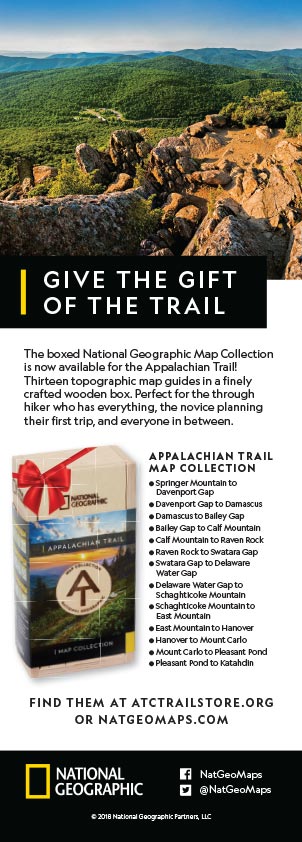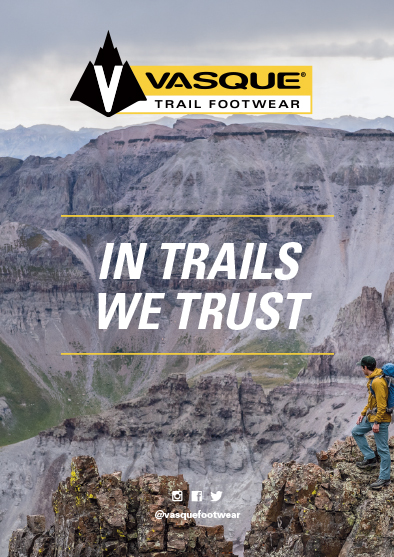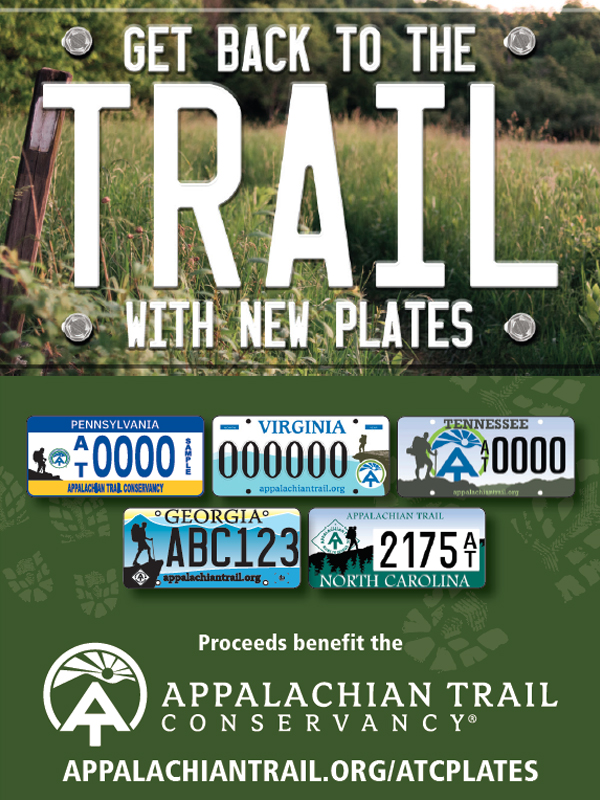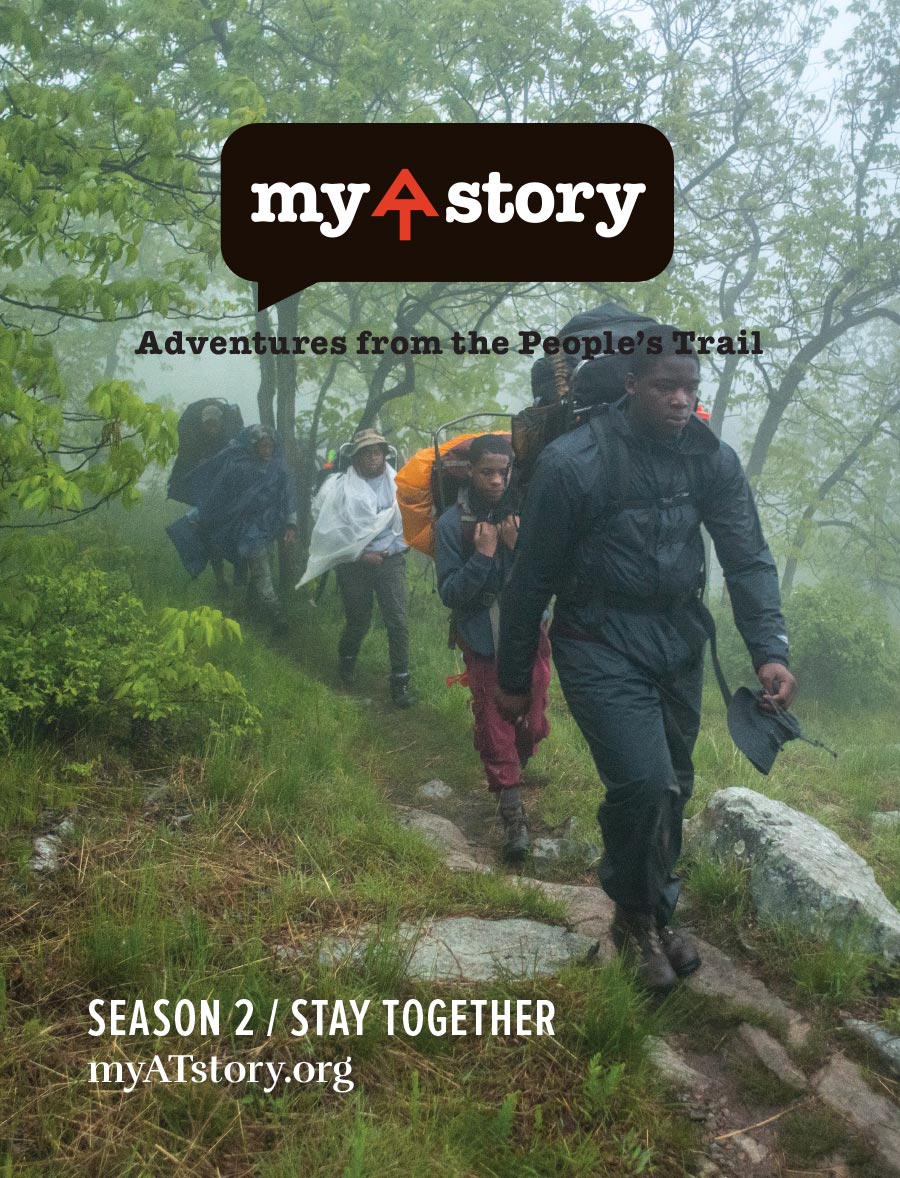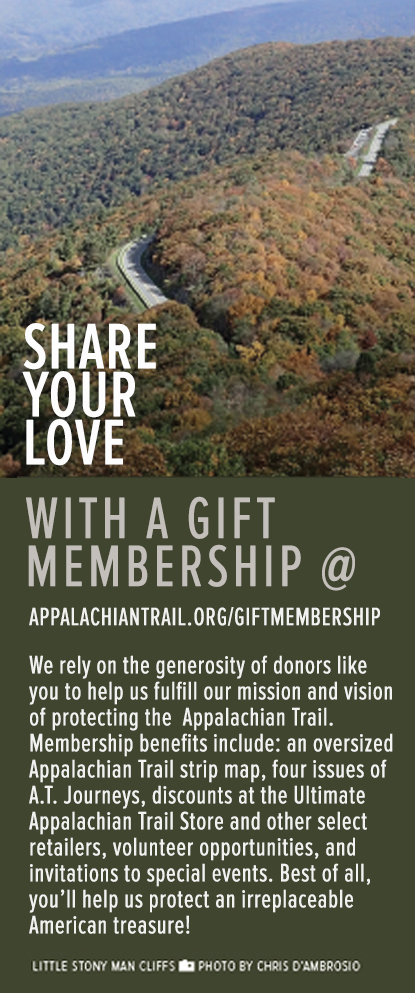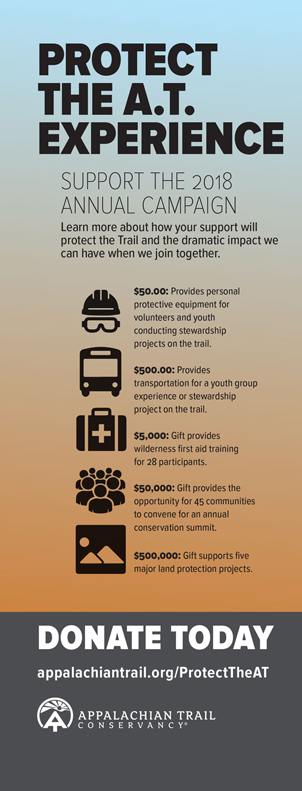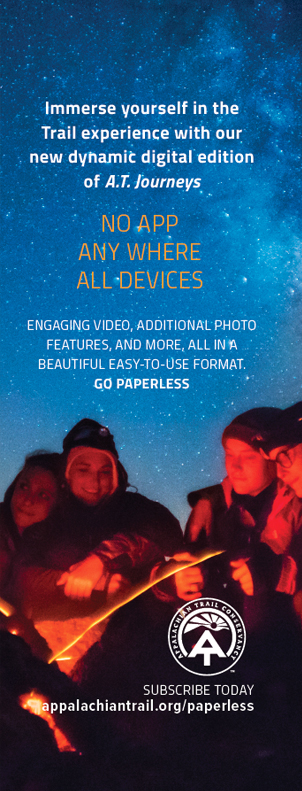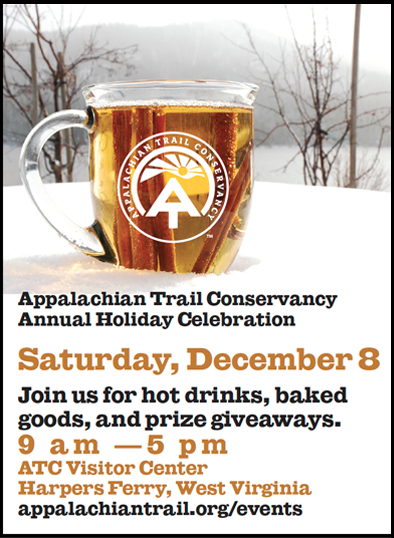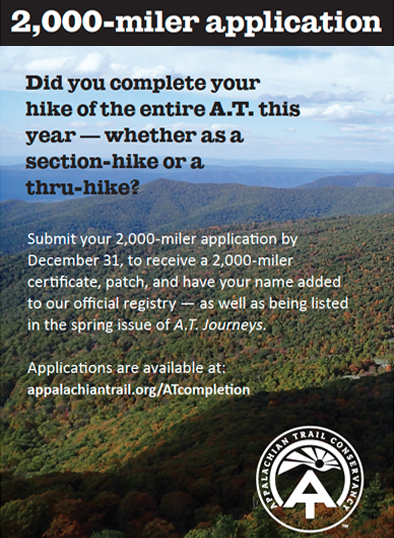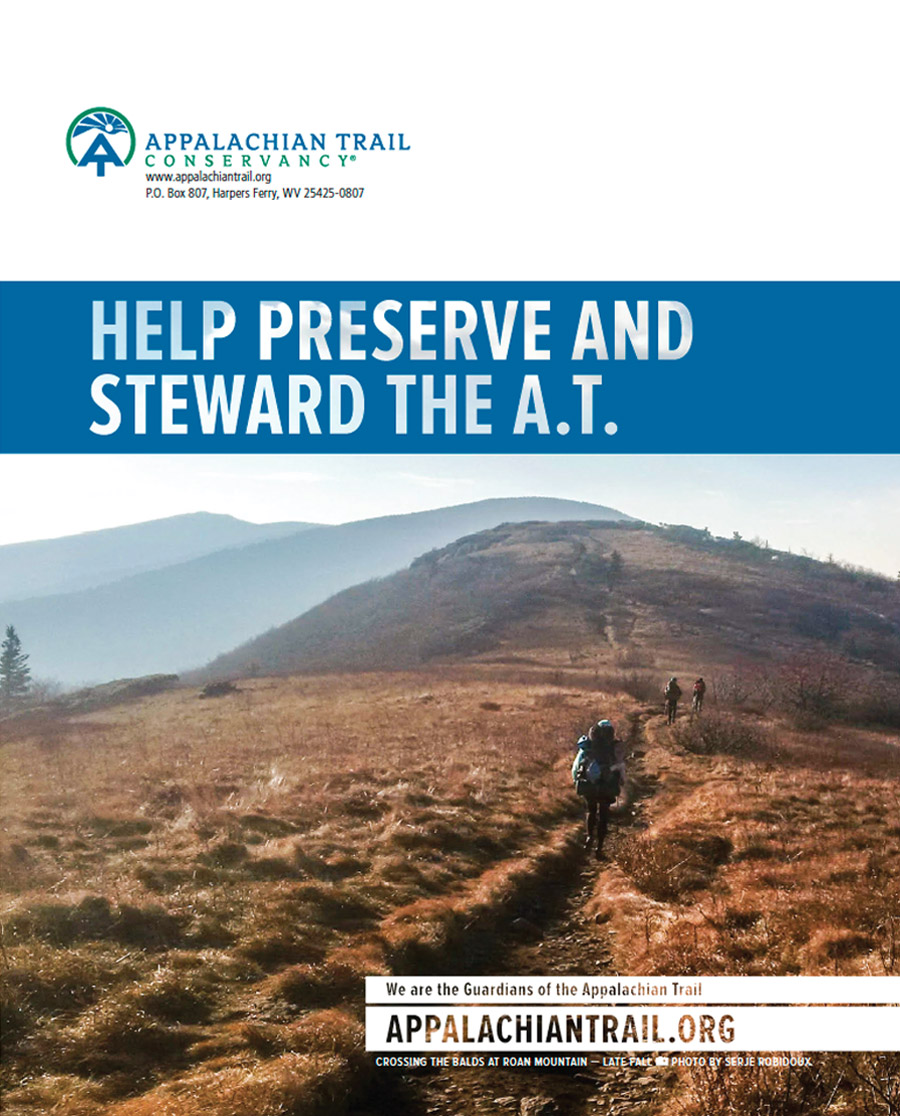

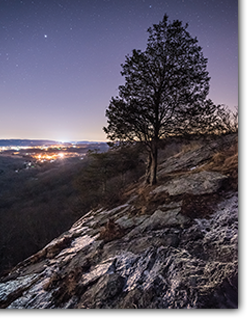
Night sky overlooking the Harlem Valley (in the Hudson Valley) from the Trail at Cat Rocks — on the border between Pawling and Dover, New York
Suzanne Dixon / President & CEO
Stacey J. Marshall / Vice President of Finance & Administration
Elizabeth Borg / Vice President of Membership and Development
Laura Belleville / Vice President of Conservation & Trail Programs
Brian B. King / Publisher
Lynn Davis / Director of Federal Policy & Legislation
Cherie A. Nikosey / Director of Human Resources
Wendy K. Probst / Editor in Chief
Traci Anfuso-Young / Graphic Designer
Laurie Potteiger / Information Services Manager
Jordan Bowman / Public Relations & Social Media Manager
Brittany Jennings / Proofreader
Sandra Marra / Chair
Greg Winchester / Vice Chair
Edward R. Guyot / Secretary
Mary Higley / Treasurer
Colin Beasley
Beth Critton
Grant Davies
Shalin Desai
Norman P. Findley
Thomas L. Gregg
Daniel A. Howe
Robert Hutchinson
James LaTorre
Colleen Peterson
Rubén Rosales
Hon. C. Stewart Verdery, Jr. / Chair
Stephanie Martz / Co-Chair
Diana Christopulos
Constance I. DuHamel
Lisa Koteen Gerchick
Jessica Herrera-Flanigan
R. Michael Leonard
Robert Rich
Thomas Torrisi
Sara Hazelwood Yanes
For membership questions or to become a member, call: (304) 885-0460
![]()
[email protected]
A.T. Journeys is published four times per year. Advertising revenues directly support the publication and production of the magazine, and help meet Appalachian Trail Conservancy objectives. For more information and advertising rates, visit: appalachiantrail.org/atjadvertising
Observations, conclusions, opinions, and product endorsements expressed in A.T. Journeys are those of the authors and do not necessarily reflect those of members of the board or staff of the Appalachian Trail Conservancy.
A.T. Journeys is published on Somerset matte paper manufactured by Sappi North America mills and distributors that follow responsible forestry practices. It is printed with Soy Seal certified ink in the U.S.A. by Sheridan NH in Hanover, New Hampshire.
A.T. Journeys (ISSN 1556-2751) is published quarterly for $15 a year by the Appalachian Trail Conservancy, 799 Washington Street, Harpers Ferry, WV 25425, (304) 535-6331. Bulk-rate postage paid at Harpers Ferry, West Virginia, and other offices. Postmaster: Send change-of-address Form 3575 to A.T. Journeys, P.O. Box 807, Harpers Ferry, WV 25425.

Looking ahead.
the Appalachian Trail as a national treasure.
The year was 1968, the year the lava lamp and the 49¢ McDonald’s Big Mac were introduced. That year, Time magazine honored the Apollo 8 astronauts and Virginia Slims boldly promoted cigarettes to women with the catchphrase “You’ve Come A Long Way, Baby.” On TV, “Rowan & Martin’s Laugh-In” reigned. On the airwaves, the Beatles’ song “Hey Jude” rocketed to number one.
the Appalachian Trail as a national treasure.
The year was 1968, the year the lava lamp and the 49¢ McDonald’s Big Mac were introduced. That year, Time magazine honored the Apollo 8 astronauts and Virginia Slims boldly promoted cigarettes to women with the catchphrase “You’ve Come A Long Way, Baby.” On TV, “Rowan & Martin’s Laugh-In” reigned. On the airwaves, the Beatles’ song “Hey Jude” rocketed to number one.
The year was 1968, the year the lava lamp and the 49¢ McDonald’s Big Mac were introduced. That year, Time magazine honored the Apollo 8 astronauts and Virginia Slims boldly promoted cigarettes to women with the catchphrase “You’ve Come A Long Way, Baby.” On TV, “Rowan & Martin’s Laugh-In” reigned. On the airwaves, the Beatles’ song “Hey Jude” rocketed to number one.
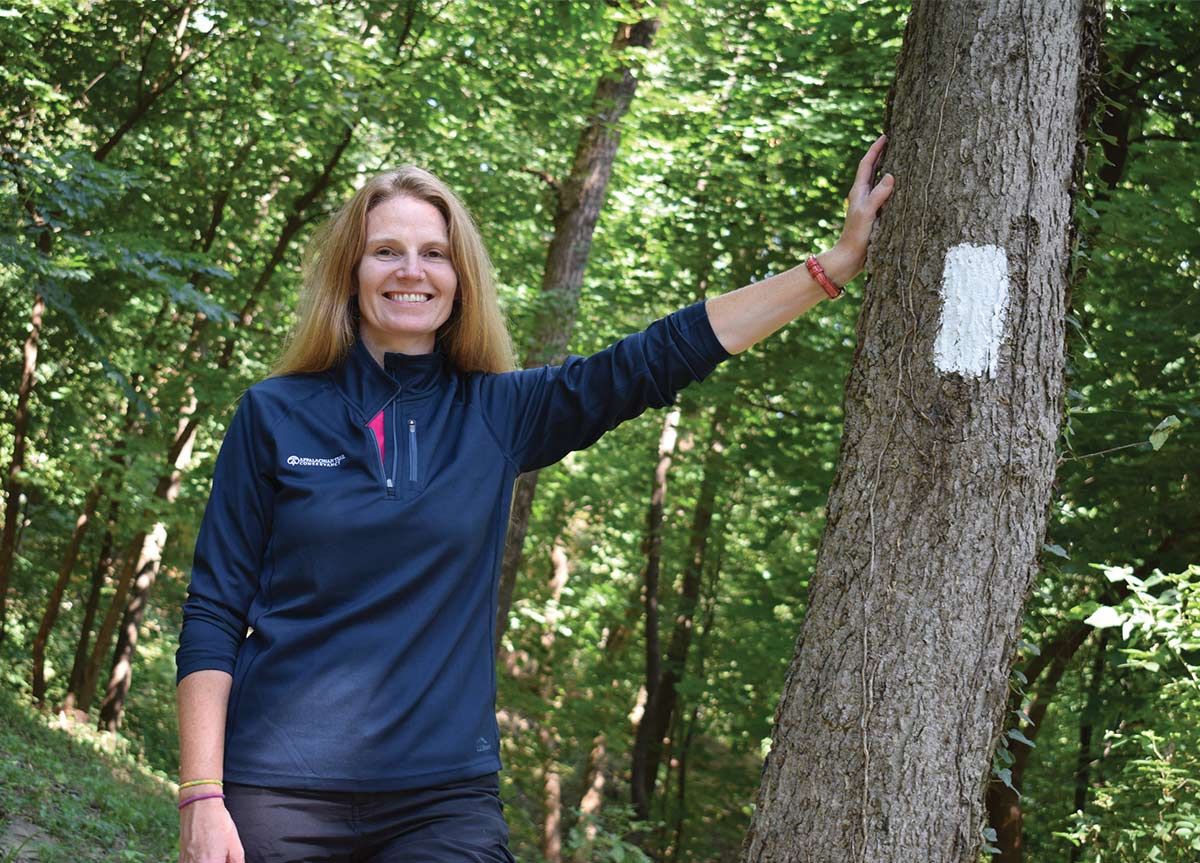
![]()
Suzanne on the A.T. near ATC headquarters in Harpers Ferry, West Virginia ![]() Photo by Jordan Bowman
Photo by Jordan Bowman
In 1968, Martin Luther King and Robert Kennedy were assassinated within months of each other, prompting thousands of people to join civil rights demonstrations and to gather along railroad tracks to honor Kennedy’s funeral train. The nightly news reported on Viet Nam War fatalities and anti-war protests; and street violence and tear gas took over the Democratic National Convention. Both political parties were split on matters of policy. By all accounts, our country seemed divided then, as it seems now.
Culturally, there was also grave concern that the increasingly ubiquitous lure of television was pulling Americans away from outdoor pursuits not so unlike current concerns about social media, online gaming, and the portable, 24/7 distraction of the smart phone.
So how was it that Congress unified behind the Appalachian Trail, pointing to its “maximum outdoor recreation potential” and its “nationally significant scenic, historic, natural, or cultural qualities?”
Perhaps it is no surprise that the Appalachian and Pacific Crest National Scenic Trails — which eventually inspired the designation of an impressive network of national trails in our country — were conceived and congressionally authorized during a time when people seemed to need places of retreat and refuge. Just as we seem to need places of solitude and beauty now.
I can’t help but think that we’re in a good moment of time to talk about the importance of the Appalachian Trail in the populous eastern United States, and to offer up unifying dialogue on how we can join together in enhancing our care for the last significant contiguous open space east of the Mississippi.
In this National Trails System Act anniversary issue of A.T. Journeys, we examine our history as we explore the future, showcasing some of the important milestones of the Appalachian Trail and providing you a peek at a forward-looking initiative called “Geotourism,” which marries Trail-town tourism promotion with vibrant stewardship.
While it cannot be denied that our united and collective perspective of our past and future is vital to the protection of the remarkable Appalachian Trail, we must not overlook our enjoyment and respect for the Trail right here and now. I speak from experience. The moments I carve out on the Trail — hiking under a canopy of trees that gently filters the sunlight or standing along a ridgeline surveying the countryside below — inspire and fuel me for our important work in preserving and protecting the Trail.
Suzanne Dixon / President & CEO
Volunteers with the New York-New Jersey Trail Conference work on the Bear Mountain project in 2017 during an introduction to trail building workshop ![]() Photo by Heather Darley/New York-New Jersey Trail Conference
Photo by Heather Darley/New York-New Jersey Trail Conference
strike the perfect balance in their dedication to the Trail.
Letters
Summer 2018 articles focusing on women on the Trail. As a young child, I met a 16-year-old girl hiking by herself on the A.T. in Massachusetts. I talked to her for a while and remember thinking to myself that someday I wanted to hike on the A.T. for a length of time. In 1982, my now husband and I hiked for five weeks on the Trail heading south from Virginia. Throughout that period, we only passed two other women, hiking together, and quite honestly, I was so excited to see them! I also recall stopping at a firehouse advertising that long-distance hikers could take a shower at their department. When we arrived, the firemen looked at me in disbelief. They said, I was the first female hiker to take up their offer. The men were ordered out of the firehouse while I showered. Over the years, I’ve noticed that more and more women are hiking the Trail and it constantly brings a smile to my face.
Debra Wasserman
A.T. Journeys would run a feature story about Delaware Water Gap (“A.T. Communities”/ Summer 2018) without even the slightest mention of Presbyterian Church of the Mountain. We have provided hospitality, accommodation, counseling, medical assistance, and meals at no cost, for thru-hikers for over 40 years; and over 900 hikers this season alone.
William “Mr. Ed” Edward Kendall
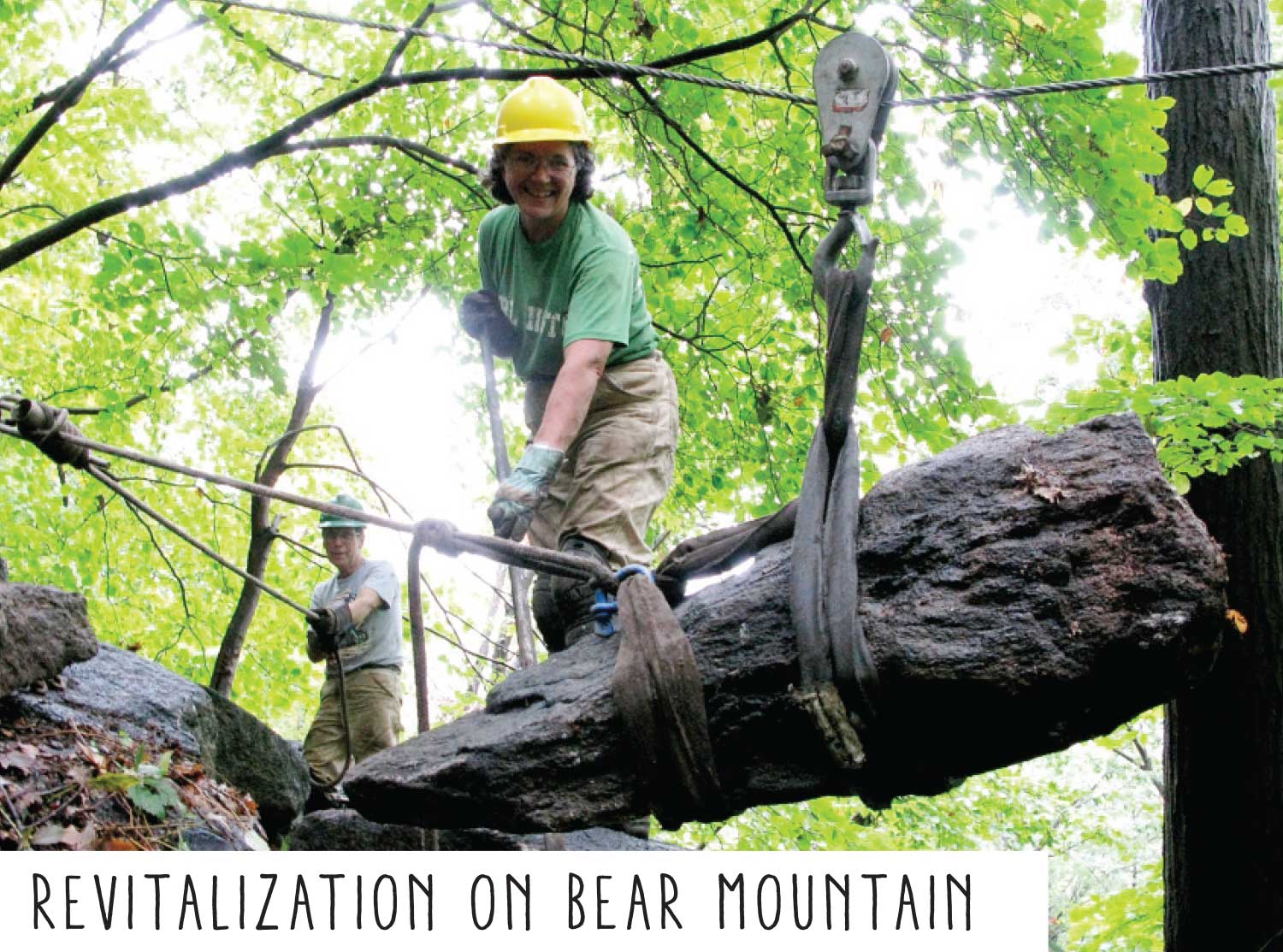

FOR NEARLY A CENTURY, LEGIONS of hikers have dug their heels into the crumbling stone and weaved between granite boulders that scatter the east face of Bear Mountain en route to its summit along the Appalachian Trail. For decades, Bear Mountain has been the gateway for urban dwellers from New York City to connect with the outdoors and the famous footpath.
By Jack Igelman


![]() PHOTO EXHIBIT
PHOTO EXHIBIT
D.C. Exhibit Showcases the A.T.’s glory, Inspiration, and Grit
Under the coffered dome in the stately U.S. Senate Russell Rotunda, the Appalachian Trail Conservancy (ATC) staged a photo-art exhibit showcasing the Trail’s scenic beauty, natural, and cultural resources — and the determination it takes to hike the entire Trail.
The September exhibit — titled “United by the Appalachian Trail” — was organized and curated by the ATC to enhance public awareness of the Trail’s importance in the eastern United States.

Land and Water
Conservation Fund
ATC Advocates
“Deferred Maintenance”
Legislation
Two important pieces of legislation before Congress are the focus of the Appalachian Trail Conservancy’s (ATC) advocacy efforts as 2018 ends. “Legislation to reauthorize and continue the Land and Water Conservation Fund (LWCF) is critical to protecting the Trail corridor,” says Lynn Davis, the ATC’s director of federal policy and legislation. The LWCF, which was congressionally established in 1964, uses earnings from offshore gas and leasing — no taxpayer dollars — to acquire lands important to meeting the conservation objectives of the National Park Service, U.S. Forest Service, and other federal agencies. The fund is generally equally split between federal agencies and states for similar purposes. This year, the Appalachian Trail benefitted greatly from LWCF with the recent acquisition of 219-acres of farmland near Pawling/Dover, New York. The acquisition — identified as the number one priority in 2018 by the National Park Service — allows the A.T. to be rerouted to a more scenic area and protects nesting habitat for a sensitive species. The $2.35 million purchase was funded mostly by LWCF with contributions from the ATC, the Trust for Public Lands, and others. Legislation to — finally — address the nation’s staggering backlog of deferred maintenance needs in our national parks is equally important to the care and management of the A.T. Increased visitation to national parks and inconsistent federal funding has, over several years, resulted in an estimated $11.6 billion backlog of necessary maintenance across the country. On the A.T., the National Park Service estimates a need for at least $20 million to primarily address infrastructure needs. In recent years, legislative attempts to address maintenance backlog have not elicited the necessary congressional support. But this year, according to Davis, “there is promising legislation in both the House and Senate that has garnered support from Democrats and Republicans alike. The ATC is optimistic about the likelihood of addressing maintenance backlog during this Congress.”
For more information visit:appalachiantrail.org/lwcf and appalchiantrail.org/backlog
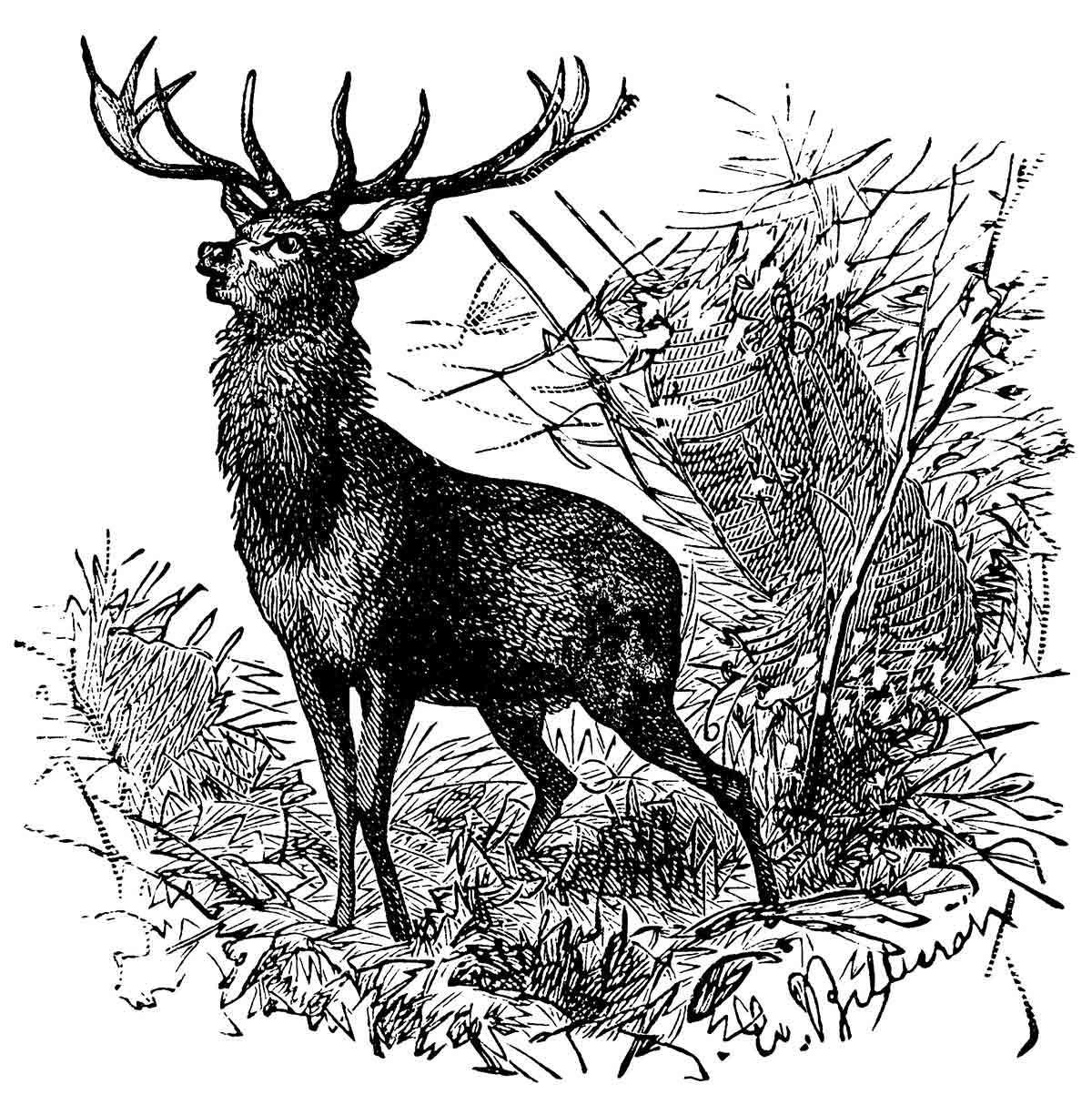
Hunting Season Safety
Hunting regulations vary widely along the Appalachian Trail. Although the A.T. is a unit of the National Park System, it traverses a patchwork quilt of public lands managed for many different purposes. Hunting is permitted within close proximity of some parts of the A.T. in every Trail state. Many segments of the A.T. in Pennsylvania north of the Cumberland Valley and a few miles of the A.T. through the G. Richard Thompson Wildlife Management area in northern Virginia are game lands managed primarily for hunting. Both hikers and hunters are advised to “know before you go.”
For more information and to see ATC’s “2018-2019 Hunting Season Guide by State” visit: appalachiantrail.org/hunting

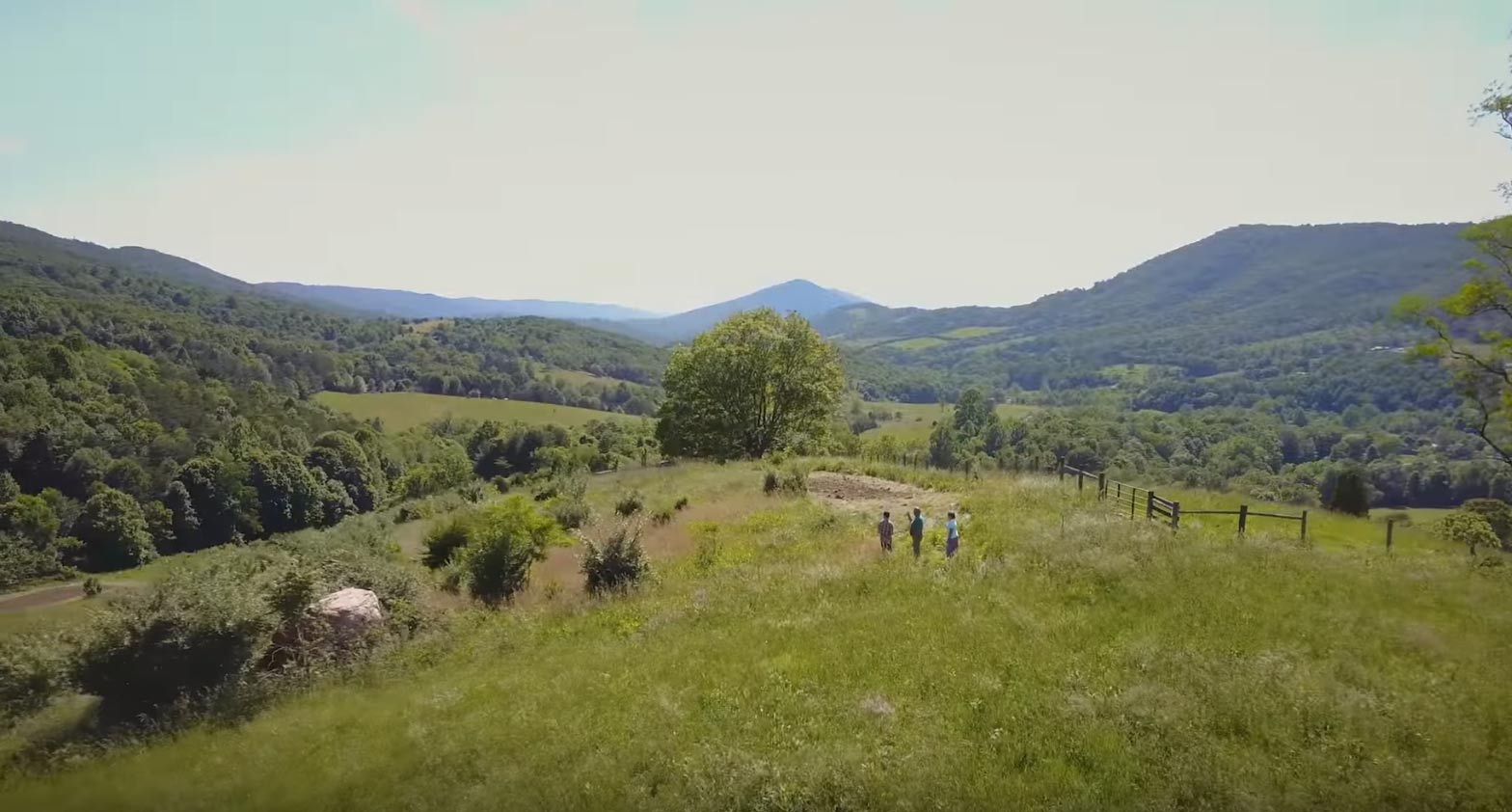
Scenes from “Mountain Valley Pipeline: A Threat to our Trail, our Water and our Jobs”
![]() courtesy Horizonline Pictures. Watch the video at appalachiantrail.org/mvp
courtesy Horizonline Pictures. Watch the video at appalachiantrail.org/mvp
Pipeline
/ By Laura Belleville
Pipeline
/ By Laura Belleville
MOUNTAIN VALLEY UPDATE
Federal authorities halted work on the Mountain Valley Pipeline (MVP) in August after an appeals court ruled that federal agencies neglected to follow environmental protections. The Federal Energy Regulatory Commission (FERC) said it had no choice but to order work on the multibillion-dollar Mountain Valley Pipeline stopped after a federal appeals court ruled that two federal agencies had neglected to follow important environmental protections when they approved the project.
Scenes from “Mountain Valley Pipeline: A Threat to our Trail, our Water and our Jobs” ![]() courtesy Horizonline Pictures. Watch the video at appalachiantrail.org/mvp
courtesy Horizonline Pictures. Watch the video at appalachiantrail.org/mvp
Florence Aftermath
Hurricane Florence posed a serious potential threat to the southern half of the Appalachian Trail in mid-September. Up to 15 inches of rain were forecast to reach the Appalachians, along with high winds. Soils were already saturated from recent rains in many areas, creating conditions for a variety of potential hazards, including falling trees, mudslides, and flash flooding. As a result, almost a thousand miles of the A.T. south of Harpers Ferry was either closed or under a strong advisory for hikers to stay off the Trail. Fortunately, the storm weakened to a tropical depression by the time it reached the Trail and reported damage has been minimal. In the coming months, hikers are advised to remain vigilant for overhead hazards, especially when choosing overnight sites.
For more information and all current Trail updates visit: appalachiantrail.org/updates


2018 Proud man/woman Award
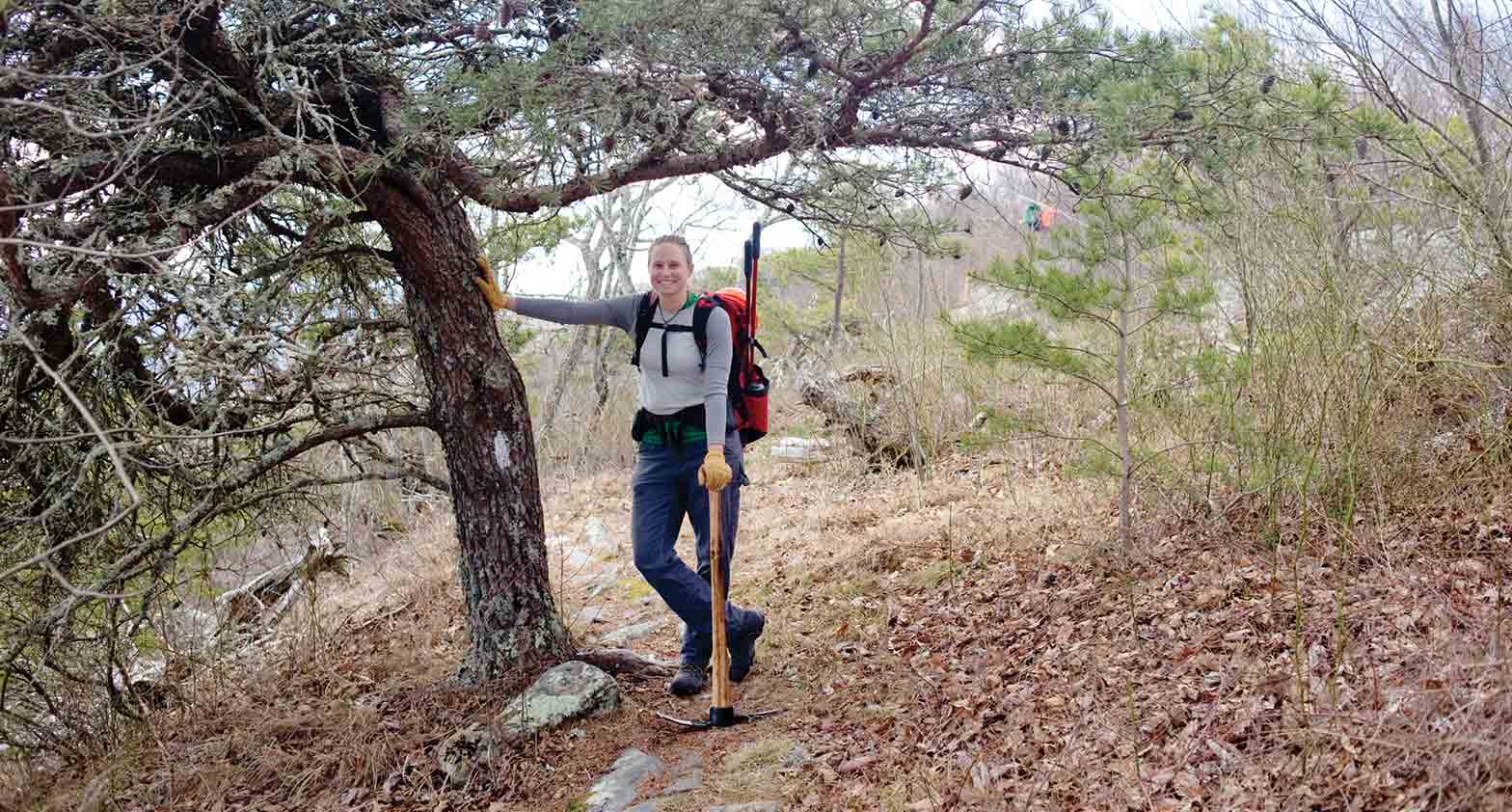
Kathryn on the section of Trail she maintains on Sinking Creek Mountain
![]() Photo by Molly Hagan
Photo by Molly Hagan
The Appalachian Trail Conservancy’s (ATC) Proud Man/Woman award — the ATC’s highest recognition for outstanding performance by a staff member — was established in 2015 to recognize the profound and enduring contributions of Bob Proudman who served the A.T. for 50 years in a variety of roles, including 35 years of employment with the ATC. The award criteria is based on demonstrated excellence in each of the ATC’s five core values: cooperation, integrity, inclusion, dedication, and empowerment. The recipient is chosen by fellow ATC employees through a nomination and committee deliberation process.
Kathryn on the section of Trail she maintains on Sinking Creek Mountain
![]() Photo by Molly Hagan
Photo by Molly Hagan

A.T. VISTA 2020
Save the Date!
Plans are underway for the first A.T. Vista to be held July 31-August 3, 2020 at Ramapo College in New Jersey. This program provides an opportunity for people who cherish the Appalachian Trail to hike, attend workshops on topics of common interest, and connect with other kindred spirits.
A.T. Vista 2020 will be a four-day weekend event hosted by the New York-New Jersey Trail Conference with engagement and participation from local A.T. Communities and other nearby partners. The A.T. Vista is the recognized program forum for activity on and near the Appalachian Trail. This will be its inaugural event, held simultaneously with the New York-New Jersey Trail Conference’s year-long centennial celebration.
Join us by volunteering or offering your services. We are also seeking topics and speakers for workshops. Visit: atvista.org and atvista2020.org for details as the A. T. Vista program unfolds. Email inquiries can be made to: [email protected] and [email protected]


Wayah Bald Tower
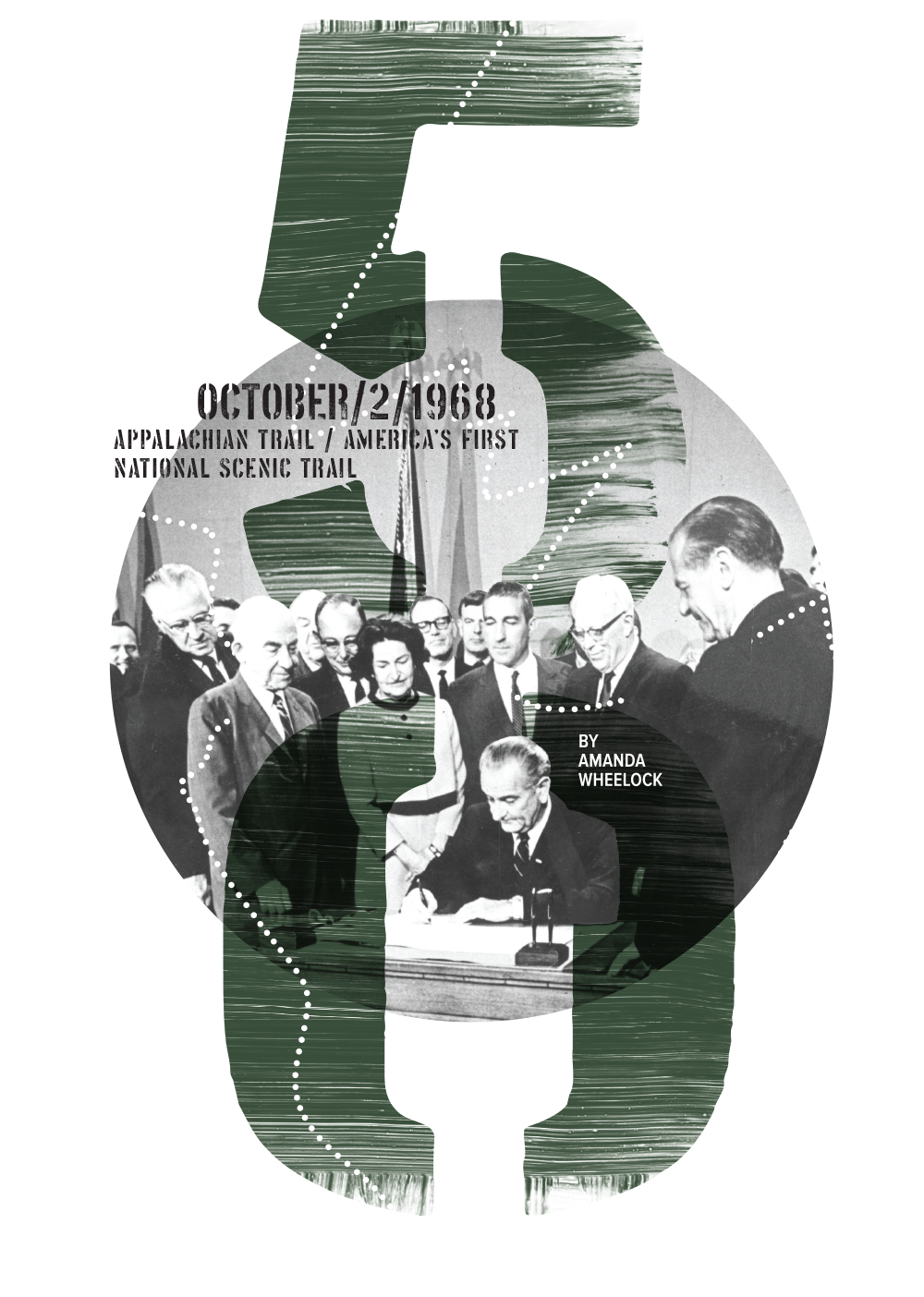

By Amanda Wheelock
From inset: President Johnson signs the National Trails System Act in 1968 ![]() Photo by Jack Rottier; The A.T. on Max Patch in North Carolina
Photo by Jack Rottier; The A.T. on Max Patch in North Carolina ![]() Photo by Greg “Weathercarrot” Walter
Photo by Greg “Weathercarrot” Walter

October 2, 1968, the Appalachian National Scenic Trail was born. Not with the nailing of a sign or the tread of a boot, as one may have imagined, but with the stroke of a pen. On a busy day of bill signing engineered to distract or, less cynically, unite the nation during a time of anti-war protests and a hotly contested presidential election, President Lyndon B. Johnson signed the National Trails System Act into law, officially designating the Appalachian Trail as America’s first National Scenic Trail.

By Shawndra Russell
have hearts of service. As Jeffrey Huffman, director of Military and Veteran Affairs at University of Central Missouri perfectly sums up, “Anecdotally, when you volunteer to join the military, you automatically have a service heart. You’re literally saying, ‘I’m willing to write a check up to and including my life, for my country.’”
Of course, that willingness to serve something larger than yourself comes with some costs. For example, the National Center for PTSD, part of the U.S. Department of Veterans Affairs, estimates that 30 percent of Vietnam veterans have had PTSD in their lifetime, as well as about 20 percent of those who have served in the more recent Iraq and Afghanistan wars. But organizations like VetsWork and Warrior Expeditions are helping veterans transition back into civilian life — with or without a PTSD diagnosis — and find a new way to serve and protect our country and its precious resources like the Appalachian Trail.
From top: UCM-Konnarock volunteers Fredy Velasquez, Jasmine Walker, and Rui Carvalho help to carry rock for stone step construction at the Big Butt to Jerry Cabin tread rehab project

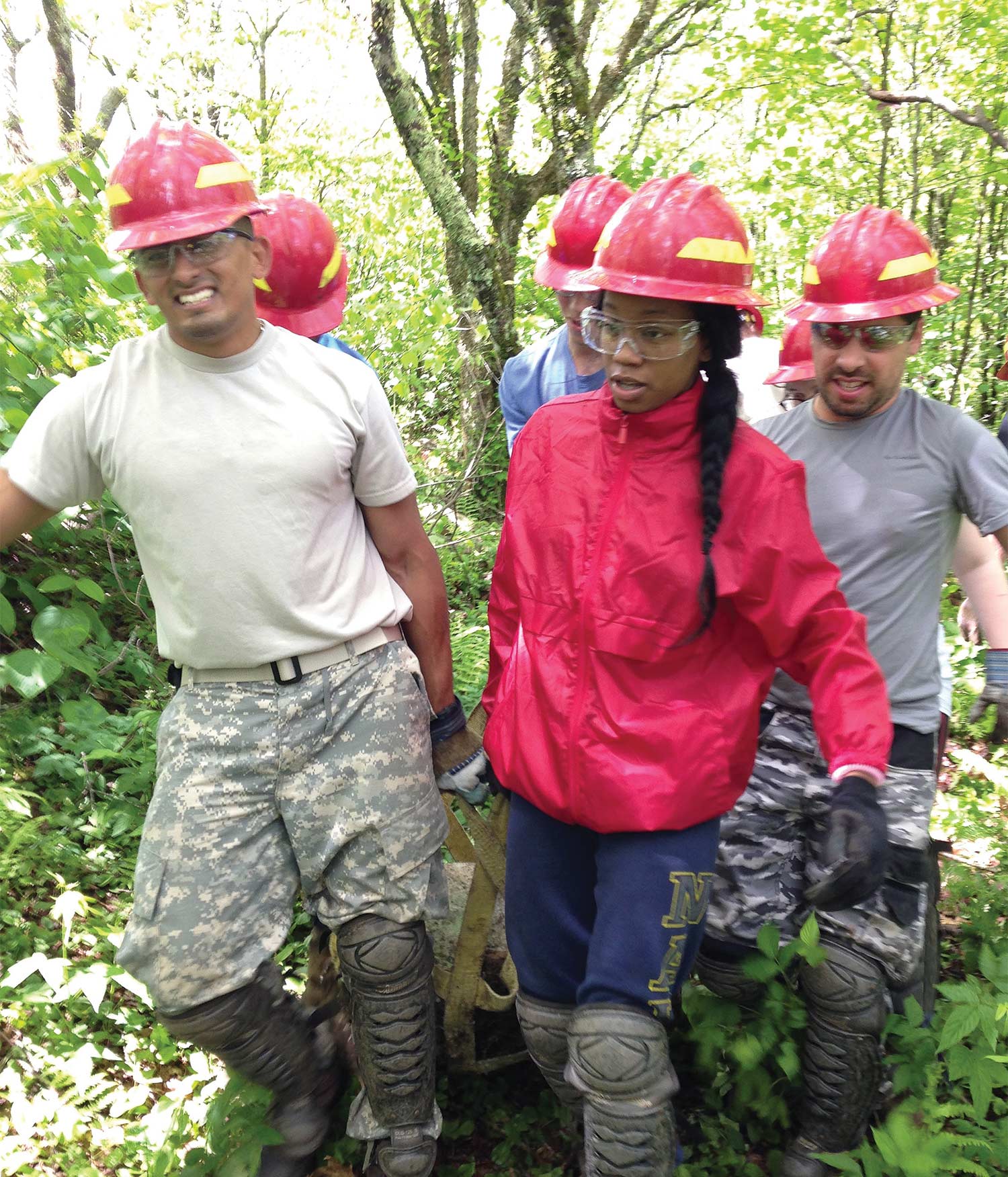

By Shawndra Russell
From left: UCM-Konnarock volunteers Fredy Velasquez, Jasmine Walker, and Rui Carvalho help to carry rock for stone step construction at the Big Butt to Jerry Cabin tread rehab project
have hearts of service. As Jeffrey Huffman, director of Military and Veteran Affairs at University of Central Missouri perfectly sums up, “Anecdotally, when you volunteer to join the military, you automatically have a service heart. You’re literally saying, ‘I’m willing to write a check up to and including my life, for my country.’”
Of course, that willingness to serve something larger than yourself comes with some costs. For example, the National Center for PTSD, part of the U.S. Department of Veterans Affairs, estimates that 30 percent of Vietnam veterans have had PTSD in their lifetime, as well as about 20 percent of those who have served in the more recent Iraq and Afghanistan wars. But organizations like VetsWork and Warrior Expeditions are helping veterans transition back into civilian life — with or without a PTSD diagnosis — and find a new way to serve and protect our country and its precious resources like the Appalachian Trail.

By Lynn Davis
GEO.TOUR.ISM
Is best described as sustaining or enhancing “the geographical character of a place — its environment, culture, aesthetics, heritage, and the well-being of its residents.”
The Towns of Dover and Pawling, New York, know they have a good thing going: travel and tourism thrive. But now the towns are taking things to the next level, working in collaboration with partners in and around the Harlem Valley — in partnership with the Appalachian Trail Conservancy (ATC) — to design and build a dynamic new “geotourism” initiative.
View from the A.T. over the Harlem Valley ![]() Photo by Julian Diamond
Photo by Julian Diamond
View from the A.T. over the Harlem Valley ![]() Photo by Julian Diamond
Photo by Julian Diamond
The Towns of Dover and Pawling, New York, know they have a good thing going: travel and tourism thrive. But now the towns are taking things to the next level, working in collaboration with partners in and around the Harlem Valley — in partnership with the Appalachian Trail Conservancy (ATC) — to design and build a dynamic new “geotourism” initiative.
Already, thousands of visitors make their way from the urban pace of New York City and Philadelphia to the serenity of the bucolic countryside, the wooded foothills of the Berkshires, and the horse farms in the Hudson Valley. On weekends and holidays, Metro-North Railroad’s Harlem Line transports New York City residents directly to the Appalachian Trail in just over two hours. It is the only rail stop located directly on the Trail, and the “station” — as local community leaders call it — is complete with posted hiking information for visitors. The area promotes a mix of outdoor recreation, arts, and culture.


Likewise, there are fewer places that have the same level of dedication this official A.T. Community has for serving its visitors and stewarding its land. Located in southeastern Carter County, the town shares a name with the mountain that the A.T. crosses, just south of town. At 6,285 feet, Roan is the highest point in Tennessee outside of Clingmans Dome in the Great Smoky Mountains. This section of the A.T. is home to the Roan High Knob Shelter, which sits at a higher elevation than any other on the Trail.
Heading northeast on Roan Mountain from Carver’s Gap, the A.T. passes over a number of spectacular views including the Round, Jane and Grassy Ridge balds
Heading northeast on Roan Mountain from Carver’s Gap, the A.T. passes over a number of spectacular views including the Round, Jane and Grassy Ridge balds
Likewise, there are fewer places that have the same level of dedication this official A.T. Community has for serving its visitors and stewarding its land. Located in southeastern Carter County, the town shares a name with the mountain that the A.T. crosses, just south of town. At 6,285 feet, Roan is the highest point in Tennessee outside of Clingmans Dome in the Great Smoky Mountains. This section of the A.T. is home to the Roan High Knob Shelter, which sits at a higher elevation than any other on the Trail.
edges of day
Julian Diamond is a full-time landscape photographer based in his lifelong home of New York’s Hudson Valley. “I try to capture familiar environments in unique or striking ways, particularly by photographing the world at the edges of day or in moody weather conditions,” says Julian. “With each photo excursion, I become more acutely aware of the fact that my camera is leading the way, and I’m just along for the ride. When I’ve been lucky enough to witness a vibrant summer sunrise, ascend a fire lookout tower deep in the forest, feel the spray of a roaring waterfall, or gaze up at a starry night sky, chances are that my craft led me to there, and that without it, I’d have missed out.” While the Appalachian Trail was something Julian had always heard of because it was so close to home, as the years went by and he continued to scout out new locations, he realized that many of his favorite photography destinations followed “a coherent corridor.” “I began to take note of the familiar white blazes that guided me to a seemingly endless variety of natural features,” he says. “The A.T. now had real meaning to me, and I eagerly immersed myself in its rich culture, studied its benefits to wildlife and land preservation, and met the people who manage, use, and maintain it. Most of my hikes are short and take place at odd hours as I await the ethereal hues of twilight, or seek refuge from the glaring, star-consuming lights of the suburbs, but that’s part of what I love about the A.T. — it truly does hold something for everyone. Through my photography, I’d like to ensure that everyone gets a chance to appreciate the A.T., and perhaps inspire someone to enjoy it for themselves.”
Sunrise from Cat Rocks
edges of day
Julian Diamond is a full-time landscape photographer based in his lifelong home of New York’s Hudson Valley. “I try to capture familiar environments in unique or striking ways, particularly by photographing the world at the edges of day or in moody weather conditions,” says Julian. “With each photo excursion, I become more acutely aware of the fact that my camera is leading the way, and I’m just along for the ride. When I’ve been lucky enough to witness a vibrant summer sunrise, ascend a fire lookout tower deep in the forest, feel the spray of a roaring waterfall, or gaze up at a starry night sky, chances are that my craft led me to there, and that without it, I’d have missed out.” While the Appalachian Trail was something Julian had always heard of because it was so close to home, as the years went by and he continued to scout out new locations, he realized that many of his favorite photography destinations followed “a coherent corridor.” “I began to take note of the familiar white blazes that guided me to a seemingly endless variety of natural features,” he says. “The A.T. now had real meaning to me, and I eagerly immersed myself in its rich culture, studied its benefits to wildlife and land preservation, and met the people who manage, use, and maintain it. Most of my hikes are short and take place at odd hours as I await the ethereal hues of twilight, or seek refuge from the glaring, star-consuming lights of the suburbs, but that’s part of what I love about the A.T. — it truly does hold something for everyone. Through my photography, I’d like to ensure that everyone gets a chance to appreciate the A.T., and perhaps inspire someone to enjoy it for themselves.”
Sunrise from Cat Rocks
profiles

Peter and Sally (with Peter’s cross-cut saw) on the section of Trail they maintain on Blood Mountain
A Beautiful Balance
By Beth Griffin
Peter and Sally (with Peter’s cross-cut saw) on the section of Trail they maintain on Blood Mountain
Peter Parsonson retired from his position as professor of engineering at Georgia Tech, he sent a letter to the Georgia Appalachian Trail Club (GATC) to inquire about becoming involved on the Trail with the club. The letter Peter received in response, and which Peter has never forgotten, told of the depths of pleasure Trail maintainers derive from their work. The letter writer spoke of the esprit de corps when working as part of a crew on bigger projects, as well as the satisfaction of looking after one’s own, “Trail section,” often alone.
trail stories
Pivotal Path
Contemplation on big life transitions
and sweet simplicity
By Niki DiGaetano
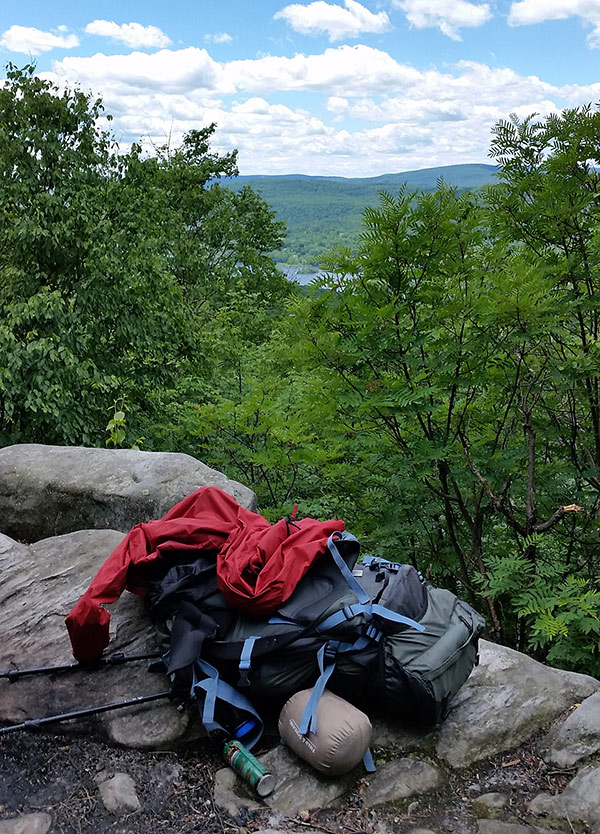
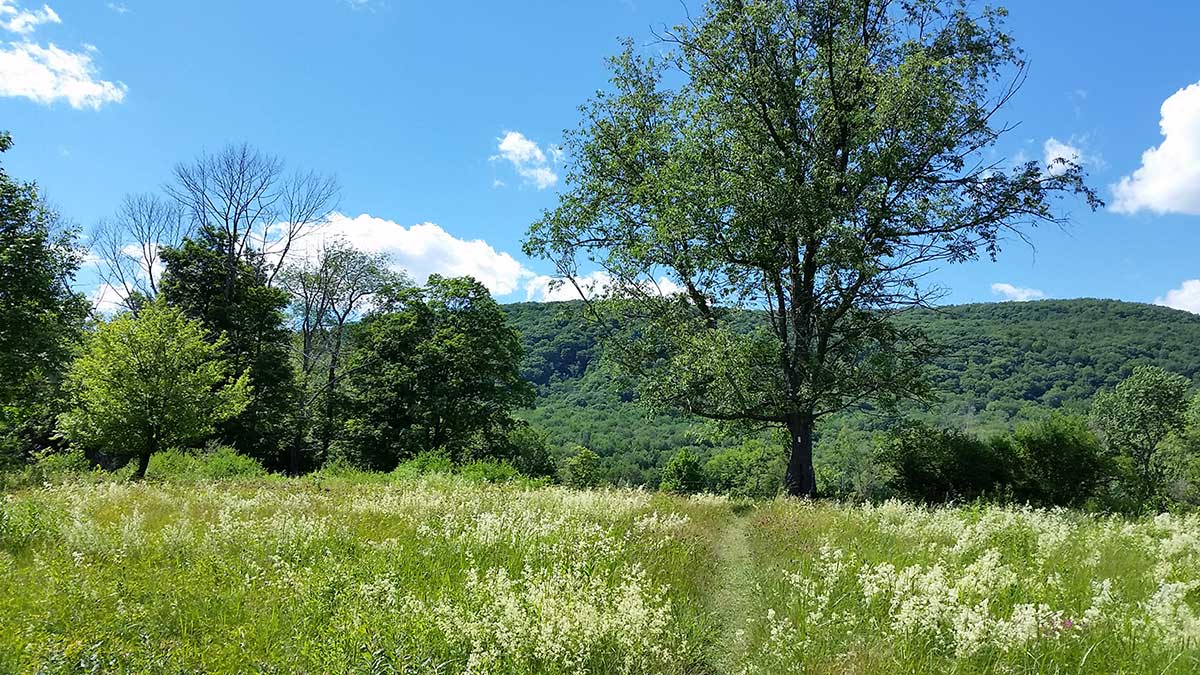
From top: The perfect stop for lunch overlooking the Cheshire Reservoir; Sunny fields and a gradual climb made for an easy start to the hike up Mount Greylock
through Massachusetts, I lost my map. Dumbfounded, I sat on a gravel road in the middle of a field, taking a break after those mighty three miles I’d walked past my starting point at Shay’s Rebellion. Tired already, there was no way I was going to go back to search for the map. For a few long minutes, anxiety threatened to swamp me like a tide; I didn’t have the names of the shelters where I was stopping written anywhere but on the map, nor I did I have a way to measure mileage or the elevation profile. I did have a guidebook, which at least contained some of the aforementioned information. Berating myself, I stood and continued walking, resigned to my mapless fate. Surely this was a practical joke: me, ever goal-oriented, always wanting to know what was coming next, being forced to continue without any indication of what lay ahead.
trail givings
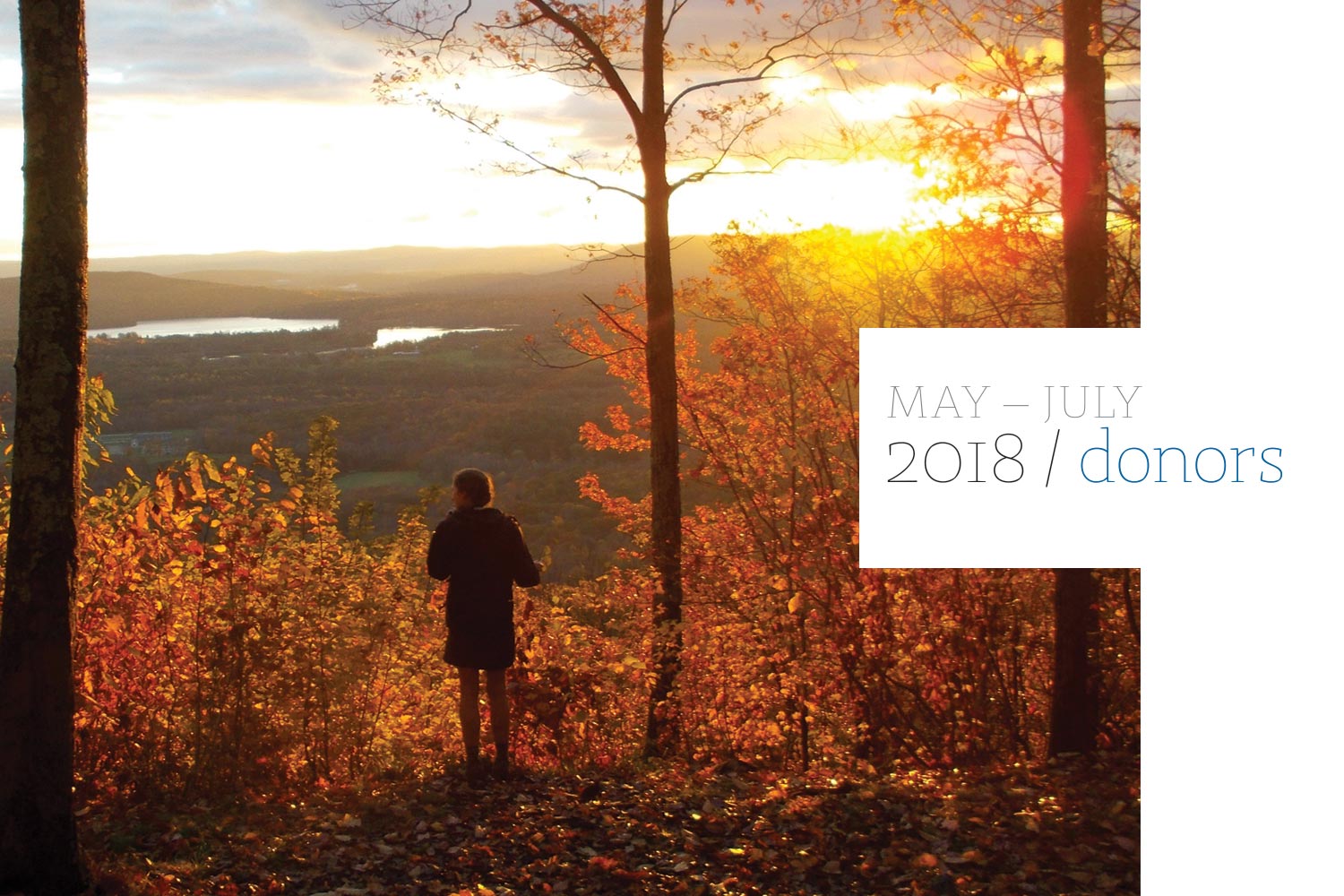
Sunrise at Riga Shelter — A.T. Connecticut ![]() Photo by W. M. Hinsch
Photo by W. M. Hinsch
Sandy Bandhu & Gigi Lopez by
Mary Lea Johnson Richards
Charitable Foundation
Joe Barnett by Deb Parvin
Mike Beeby by Joel Beeby
Kenneth Bird, Jr. by Geoffrey Bird
Roger Busler by Forrest Busler
Dick Clark by Curry Fisher
Mark Cohen by Michael Cohen
Charles Cole by Sheila Wells
Duncan Crawford by Lori Crawford
Paul Curtin by Aileen Curtin
Suzanne Dixon by Rubén A. Rosales
Jason Frink by Kathleen Frink
Christopher & Sarah by Gail &
John Buchanan
Jessa Hackman by Anna Feeley
Skipper Hebrard by Laurie Hebrard
Black Hedrick by Helen Landmesser
Julia Hoeh & Sean Casler by
Matthew Hamilton,
Judith McCandless
Joey Hopkins by Joey Hopkins
Zach Jones by Eva Hathaway
Joel Killough & Stephanie Jones by
Deb Killough
Anna Knoy by Sara Poplin
Jim LaTorre by Nancy Frohman,
Anthony LaTorre, Mollie LaTorre
Michael & Kathy Lecomte by Krissa
Crawford
Harvey Lewis by Luke Thoreson
Kristen Lewis by Danielle Fluke
Kathy, Maggie & Greg Marryat by
Carrie Powell
Stacey Marshall by Arthur Foley
Cyndi Marvin by Jaclyn Walters
Bruce Matson by Bob & Betsy Smith
Kent Merkey Anne Mitchell
Terry Newton by Leeann Ryder
Mike & Anna Ollinger by
Annetta DePompa
Brenda Payne by Lisa Miller
Carson Peck by Angela Hopkins
Julie Petruska by Adil Godrej
Dianna Poling by Arthur Foley
Chuck Porter by JoAnne Smart
Richard Ramsay by Brian Earp
Dave Shipman by Nona Shipman
Richard Simons by Alexandra Simons
Dave Smith & Linda Black by
Karen Dribben
Richard Snyder by Jayne Snyder
Brittany Spencer by Donna Spencer
Dave Tarasevich by Shepherd’s Spring,
Inc.
Mike Terrell by Megan Terrell
The Trail Blazing Women of Kean
University by Michael Burns
Sarah Tuthill & Chuck Porter by Gillian
Murrey
Jeff Walsh by Frederick Klein
Will Wickham by John Gleason
Karen Wilcox by Helen Beesley
Kevin Wilson by Erin Wilson
Sandy Bandhu & Gigi Lopez by
Mary Lea Johnson Richards
Charitable Foundation
Joe Barnett by Deb Parvin
Mike Beeby by Joel Beeby
Kenneth Bird, Jr. by Geoffrey Bird
Roger Busler by Forrest Busler
Dick Clark by Curry Fisher
Mark Cohen by Michael Cohen
Charles Cole by Sheila Wells
Duncan Crawford by Lori Crawford
Paul Curtin by Aileen Curtin
Suzanne Dixon by Rubén A. Rosales
Jason Frink by Kathleen Frink
Christopher & Sarah by Gail &
John Buchanan
Jessa Hackman by Anna Feeley
Skipper Hebrard by Laurie Hebrard
Black Hedrick by Helen Landmesser
Julia Hoeh & Sean Casler by
Matthew Hamilton,
Judith McCandless
Joey Hopkins by Joey Hopkins
Zach Jones by Eva Hathaway
Joel Killough & Stephanie Jones by
Deb Killough
Anna Knoy by Sara Poplin
Jim LaTorre by Nancy Frohman,
Anthony LaTorre, Mollie LaTorre
Michael & Kathy Lecomte by Krissa
Crawford
Harvey Lewis by Luke Thoreson
Kristen Lewis by Danielle Fluke
Kathy, Maggie & Greg Marryat by
Carrie Powell
Stacey Marshall by Arthur Foley
Cyndi Marvin by Jaclyn Walters
Bruce Matson by Bob & Betsy Smith
Kent Merkey Anne Mitchell
Terry Newton by Leeann Ryder
Mike & Anna Ollinger by
Annetta DePompa
Brenda Payne by Lisa Miller
Carson Peck by Angela Hopkins
Julie Petruska by Adil Godrej
Dianna Poling by Arthur Foley
Chuck Porter by JoAnne Smart
Richard Ramsay by Brian Earp
Dave Shipman by Nona Shipman
Richard Simons by Alexandra Simons
Dave Smith & Linda Black by
Karen Dribben
Richard Snyder by Jayne Snyder
Brittany Spencer by Donna Spencer
Dave Tarasevich by Shepherd’s Spring,
Inc.
Mike Terrell by Megan Terrell
The Trail Blazing Women of Kean
University by Michael Burns
Sarah Tuthill & Chuck Porter by Gillian
Murrey
Jeff Walsh by Frederick Klein
Will Wickham by John Gleason
Karen Wilcox by Helen Beesley
Kevin Wilson by Erin Wilson
As I See It

Earl Shaffer on Katahdin at the completion of his thru-hike in 1948
history that was made in 1948 was the appearance of the first “thru-hiker,” Earl V. Shaffer of York Springs, Pennsylvania, who reported completing the entire 2,050 miles in an uninterrupted backpacking trip beginning April 4 and ending August 5. Shaffer had lost his closest friend while they were in combat in the Pacific Theater and was “walking off the army” by “walking with spring” — the title of his book about it — along the Appalachian Trail he had read about in a magazine.
While he was halfway to Maine, the already legendary Myron H. Avery was presiding over the Appalachian Trail Conservancy’s first postwar, regrouping meeting, at Fontana Dam in North Carolina — part of which was devoted to a discussion on how unlikely a thru-hike would be. The chairman was particularly disturbed that Shaffer had no official guidebooks and maps. Shaffer, “The Crazy One,” as he called himself, said he wrote for but never received the maps, so instead used oil-company maps and whatever he could pick up at parks and forests along the way.
Shaffer’s account is still accepted as the first reported thru-hike; the ATC neither investigates nor endorses such reports.
After he reported his feat to the ATC, Shaffer underwent at least one “charming… grilling,” as he would later put it, primarily by editor Jean Stephenson — place questions, people questions, photographic evidence, Trail-condition questions. After that, she and, through her, Avery would accept the report. Stephenson did note two “off track” sections, which Shaffer acknowledged and blamed on poor signage or unmarked relocations during that recovery period.
Shaffer hiked the Trail again in 1965, from the other direction, and once more as a 50th-anniversary trek in 1998 at age 79 — complaining bitterly all the way about route changes from roads up to mountaintops away from towns.




